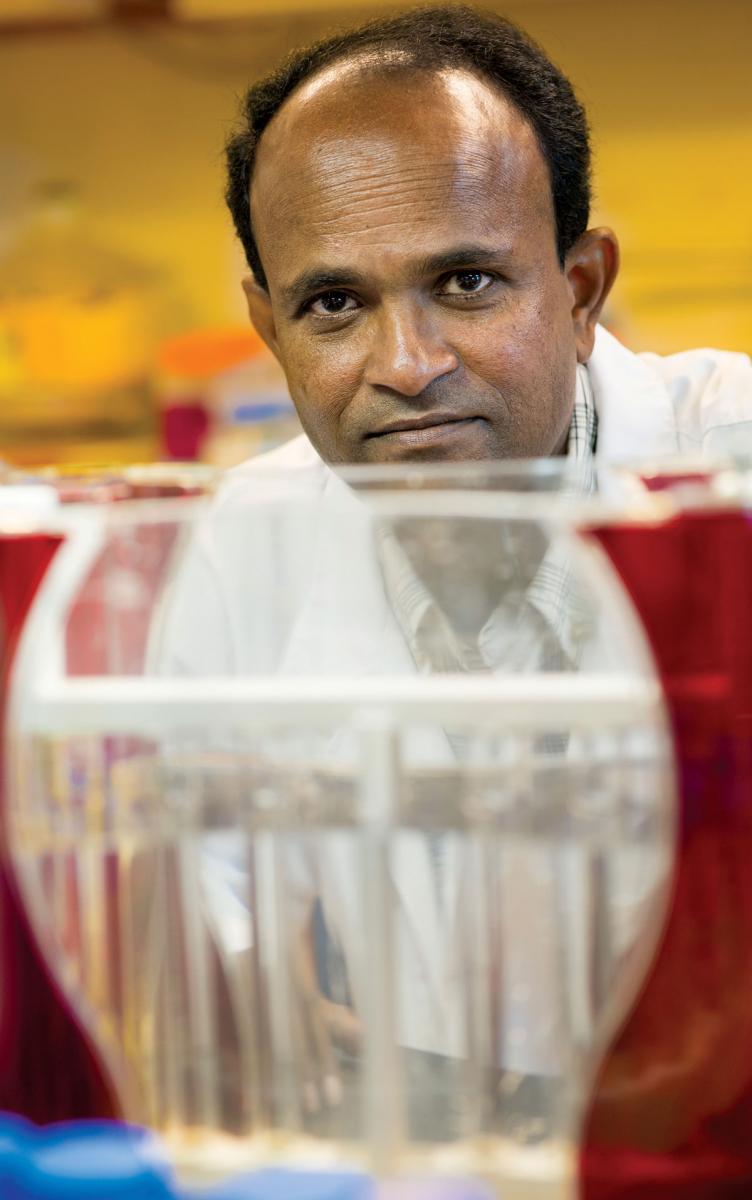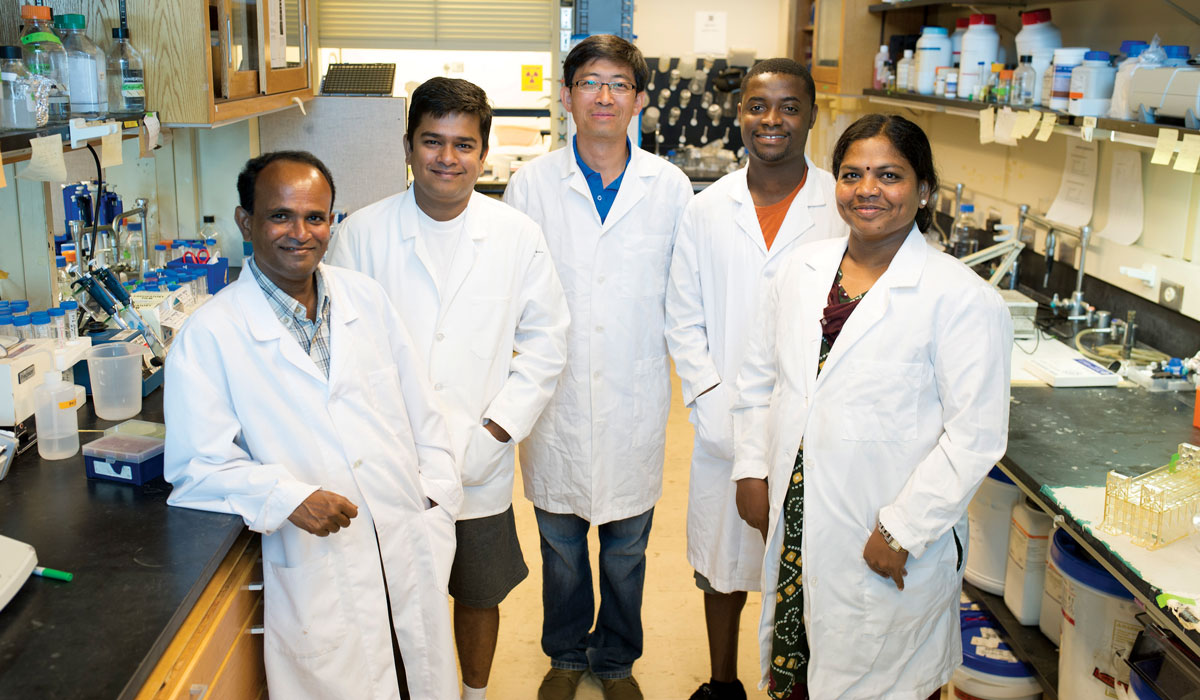Sunkar Taking the Lead
Monday, November 9, 2015

If Oklahoma State University’s Department of Biochemistry and Molecular Biology had a rock band, Ramanjulu Sunkar would be the lead vocalist. If it had a baseball team playing in the World Series, he’s the one who would be coming to the plate with the bases loaded. He would be the main character in a blockbuster movie. Get it? He’s a big deal.
And most recently, he was included on the Thomson Reuters Highly Cited Researchers list for 2014. Sunkar, associate professor of biochemistry and molecular biology, has been cited by his peers nearly 6,500 times since 2009, putting him in the top 1 percent of researchers in his field.
“Dr. Sunkar is engaged in incredibly high-quality science and is truly having significant impacts on his field of study,” says John Gustafson, biochemistry and molecular biology department head. “Our department is extremely proud of him and his work since he joined us as a colleague in 2006.”
The Highly Cited list includes 3,200 researchers representing 21 fields in the sciences and social sciences. Sunkar, the first OSU faculty member to earn this acclaimed distinction, is among 80 named in the plant and animal science category.
“Our goal for the Division of Agricultural Sciences and Natural Resources is to continue building on our traditions of excellence. This honor for Dr. Sunkar’s research productivity and impacts gives further evidence that our scientists are achieving those aspirations,” says Thomas Coon, DASNR vice president, dean and director. “I commend him and his colleagues for the recognition they deserve.”
Sunkar isn’t one to sing his own praises. Still, he recognizes the significance of such an accomplishment.
“I am pleased and honored to be named on this list,” Sunkar said. “I’m also very excited about seeing where this research can take us.”

The researchers on this list are on the cutting edge of their fields, performing and publishing work their peers recognize as vital to the advancement of their scientific discipline. An extremely effective way of judging a researcher’s work is by looking at how often other researchers quote and cite him or her.
“Citation is a direct measure of influence on the literature of a subject, and it is also a strong indicator of scientific contribution, since it is derived from a pattern of interaction among millions of published articles,” the Highly Cited website (www.highlycited.com) says. “Scientists who are often cited have more impact in their field and exert greater influence on their colleagues around the world.”
Much of Sunkar’s research is focused on drought, salt and heat tolerance in plants and involves using molecular techniques. Since plants can’t pack up and escape suboptimal environmental conditions, they must endure various environmental challenges such as increased soil salinity, drought and extreme temperatures.
A plant’s stress tolerance is determined by the proper spatial and temporal regulation of genes, producing optimal levels of response proteins. This is critical for plants to survive stressful conditions. As the global climate changes and the world population rises, available water sources are shrinking. Sunkar’s research is identifying properties plants possess that allow them to withstand many of the stressors they face.
“Dr. Sunkar’s work is very well received by his peers, since his research has uncovered a whole new class of gene regulators that many other scientists had not yet identified,” says Gustafson. “In addition, Dr. Sunkar now provides tools and observations required to uncover these gene regulators in a variety of other species, which other researchers benefit from.”
Some of his most popular work among his peers was the identification of miR156, a molecule in switchgrass, which, upon manipulation, leads to an increase in biomass production. The potential impacts of this discovery leave little doubt as to why Sunkar is becoming a worldwide name.

“The work that Dr. Sunkar is presently pursuing at OSU is exceptional. He is credited with the discovery of several new ‘microRNAs’ that were unknown to the plant community,” says Gustafson. “His laboratory also demonstrated that these relatively small gene regulators are able to control the expression of genes important to plant development and their ability to withstand stress.”
Proteins are important molecules in living organisms, especially multicellular life forms, which have numerous different cell types with varying functions.
“The various proteins, their differential quantities and the times they are produced in different cell types create the cell variability we observe in single multicellular organisms – such as people for instance,” Sunkar says. “The proteins are produced from the messenger RNA molecule, which in turn was produced as a result of activation of genes present in the DNA.”
Sounds simple, right?
“However, there is a layer of regulation between messenger RNA and protein, which has been discovered only recently. This newest level of gene regulation is mediated by the small molecules called ‘microRNAs,’ ” he says. “These molecules will determine where, when and how much of a specific protein needs to be produced, which is critical for the normal development of plant species, especially plants attempting to survive under stressful conditions.”
As Sunkar’s lab is responsible for the discovery of several new microRNAs in switchgrass, scientists from around the globe have been looking for these molecules in different plant species.
“If we have an understanding of it, we can move the technology forward with an educated public and produce crop varieties that can better withstand the stresses that a modern, transforming earth is putting on them,” Gustafson says. “Dr. Sunkar is the one creating and describing it to the scientific community so they can latch on.”
Sunkar’s research is a launching pad for opportunities in the biofuel market. With field trials taking place in Tennessee, the results are promising.
“Dr. Sunkar’s discoveries could have a huge impact in the future, when and if the research he pursues is applied to agriculturally important crops, which the population requires to feed themselves in an ever-changing planet,” Gustafson says. “In particular, application of his discoveries could lead to the production of safe, stress-tolerant crops or plants that produce more biomass. These stress-tolerant crops could potentially grow in warmer climates with less moisture, and the plants that produce more biomass could be utilized for alternative energy production.”
Until these new discoveries take hold and are put to good use, we can all sit back, give Sunkar a standing ovation and wait for his next act.
